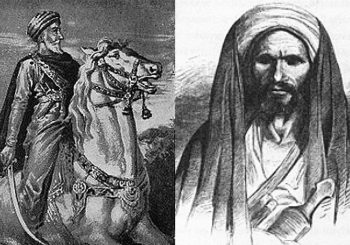
Was she really a woman? Fatima contemplates, as her grandmother walks inside the tent, covered in a large dark-blue garment that absorbs every atom in the air, and carries the vastness of the desert with it. The desert’s landscape is only a natural extension of the incomparable space she controls; no human cell ever moved freely under her watch.
Grandmother Hakima is the great demon. The tent is akin to an ant she steps on wherever she walks. She clasps every human heart in her hand as though they were nothing more than dead flesh that can be either kept or sold. For her, the other women in the family are either wretched, crippled, possessed, or demented. Their lives are like silent, motionless seas without waves, and every now and then, a sea creature — a husband — shatters the surface by leaping through it.
The Tent (1996) is a novella written by Egyptian author Miral Al-Tahawy, which dives into the heart-wrenching experiences of Bedouin women and how the difficulty in their lives leads them to suffer from mental illnesses. Through the eyes of Fatima, the reader enters the hidden worlds of other women and their diverse lives.
The idea of a ‘Bedouin woman’ is not reduced to one stereotype or concept, but several characters: there is the gypsy girl, Mouha, who roams the desert freely, the slave girl, Sasa, who often tries to escape the oppression of her family by going to the market, and Fatima’s three older sisters: Safiya, the maternal one, and Fouza and Rihana, who embroider and sing all day.
Yet, all of the women live under the tyrannical rule of grandmother Hakima, who despises them for having been born daughters instead of sons. Fatima’s mother suffers from severe depression for bearing an abusive mother-in-law and an absent father, while the rest of the women, including Fatima, struggle to balance between two worlds: the real and the imaginary.
The novella is difficult to read at first as there is neither a clear plot nor a descriptive introduction of all of the characters; it is a stream of Fatima’s thoughts and feelings. For instance, Anne – a foreign anthropologist – suddenly appears with Fatima’s father without any context or introduction, but by the end of the novella, the reader recognizes that there is an underlying theme that connects all of these different women together.
All of the women reproduce each other’s oppression. Their outside world mirrors their internal struggles, and because they are confined both internally and externally, their interactions with one another contribute to their own oppression, which creates a cycle that turns one woman’s oppression into another woman’s experience. “My heart was a lake of dried salt,” Fatima says at the end of the novel, as she realizes that she had ended up like her mother and has experienced the oppression she had also faced.
The women’s mental illnesses are also brought to the forefront of the story, revealing the impact of life’s events on their mental health and core identity. Since women are often told to prioritize their families over themselves, their mental well-being is seen as an afterthought, or simply a sign of their incompetence to fulfill the role of a good wife.
Al-Tahawy, in her novel, erases the superficiality of womanhood. For instance, she does not celebrate the coming-of-age story of Fatima, and her journey from girlhood to womanhood, but allows the reader to question the painful shortcomings of that period of transition. Fatima does not become a powerful woman, nor does she reach any groundbreaking success or enlightenment, but is instead left disabled at the end of the journey. There is neither a grand prize nor real happiness. Fatima, like the rest of the women in her family, ends up with severe depression.
Al-Tahawy also brings to light a different kind of confinement that forces Fatima, like her mother, to lose touch with her sanity and freedom. She is used and exploited by Anne —a Westerner who is obsessed with Bedouin culture; Anne adopts Fatima temporarily, exploiting her knowledge for her own work and hosts parties where Fatima shares Bedouin folktales and myths for entertainment to Anne’s guests.
Al-Tahawy illustrates how women’s confinement continues to exist and evolve across generations. Whether it is inside a tent or the home of a Westerner, the Bedouin women in the novel are confined to two conflicting spaces: the space of being valued for their ability to fulfill the role of a mother and maintain the strength of the tribe, and on the other hand, the space of being objectified, molded and reduced to an object that has no power over their own image and freedom.
Fatima’s relationship with Anne is an example of how she (Fatima) continues to emulate the generational practice that restricts a woman’s role to a provider. Regardless of the education she receives, her image is molded by other people — the image that Anne has of what a Bedouin woman should behave and look like.
Hailing from a Bedouin background, Al-Tahawy’s novel presents an illustrative example of how the lived experiences of women from different cultural communities can be narrated in a way that reveals the similarities, rather than the differences, with the experiences of women worldwide. Through her narration, Al-Tahawy allows the reader to focus on the individual experiences of Fatima rather than feel too distracted by cultural symbols and meanings. As a reader, the struggles of Fatima feel much closer to one’s own emotional experiences of pain and loss, rather than as experiences of a foreign person.
As Caroline Seymour-Jorn, associate professor of comparative literature and Arabic translation at the University of Wisconsin-Milwaukee, points out in an article, Al-Tahawy’s novella highlights the individuality of individuals and their own individual experiences to challenge the “monolithic and simplistic understandings of cultural worlds”. Rather than putting the spotlight on Bedouin culture, Al-Tahawy’s novel sheds light on the human experiences and emotions that are infused with traces of Bedouin culture.
Bedouin culture is imbued with expressions of love, yearning and despair through a poetic division of the chapters of the book. Each chapter starts with a Bedouin poem that sets the tone for the rest of the chapter. While Bedouin culture is often stereotyped to be aggressive, harsh and devoid of human emotion, Al-Tahawy presents Bedouins as tender and fragile individuals, who are very much affected by their surroundings and experiences of love.
This is most evidently seen through Fatima and her strong relationship with animals and nature, her only sources of love, warmth, and peace, as she struggles to cope with the realities of a mentally distressed mother, an absent father, and a cruel grandmother.
The novella is a shattering tale on mental health and womanhood, forcing the reader to think more deeply about the experience of becoming a woman in a patriarchal society. Like the confined space of the tent, women with mental illnesses are hidden and barricaded inside a world that does not allow them to mould their own image of who they truly are.







Comment (1)
[…] Review: ‘The Tent’ Exposes the Mental Health Burden of Bedouin Women […]